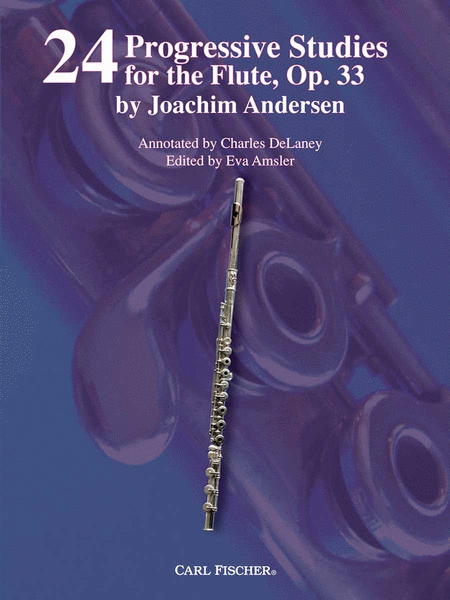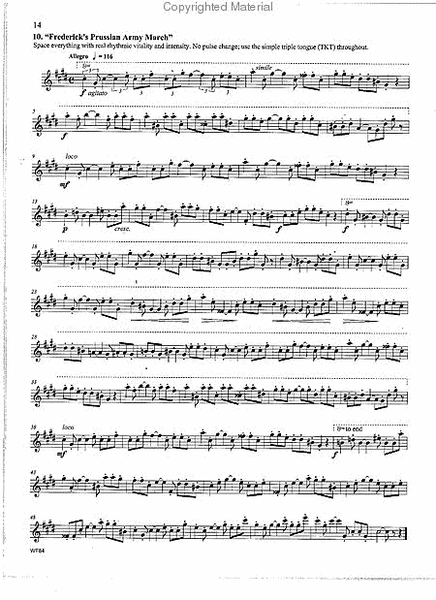24 Progressive Studies for the Flute, Op. 33
-
Ships in 24 hours
Details
Description
SKU: CF.WF84
Composed by Karl Joachim Andersen. Edited by Eva Amsler. SWS. Back To School. Collection. With Standard notation. 32 pages. Carl Fischer Music #WF84. Published by Carl Fischer Music (CF.WF84).ISBN 9780825868672. UPC: 798408068677. 9 X 12 inches.
Carl Fischer Music presents a new spin on a classic teaching method with this edition of Joachim Andersen's 24 Progressive Studies for the Flute, Op. 33. While all of the original etudes are included, flute pedagogue Professor Charles DeLaney has expanded them to include notes in the upper range of the instrument, updating this book for the flute's modern incarnation. DeLaney also lends his sharp wit to this edition, having cleverly named the etudes and also has provided helpful and humorous practice notes for each. As a special bonus, this book also features DeLaney's Daily Dozen, a set of practice exercises guaranteed to improve technique and musicality. Essentially a complete method built on a proven collection of etudes, Delaney's edition of 24 Progressive Studies for the Flute, Op. 33 is absolutely essential for serious flute students. For intermediate to advanced players.
I am happy to be able to present the Andersen/DeLaney Etude and Daily Exercises book and, in doing so, to be able to honor Charles DeLaney for a lifetime of superior teaching. This book represents Mr. DeLaneys excellent teaching ideas in two parts: The DeLaney Daily Dozen and the Andersen Op. 33 etudes, to which Mr. DeLaney added his own written annotations and commentaries. These commentaries, which feature a unique combination of wit and practical advice, are reproduced verbatim in this edition. Delaney explored the idea of playing the flute in the fourth octave, thus extending the range to learn how to support and play more evenly. It is often the case that after mastering the difficult fourth-octave fingerings, everything else seems comparatively easy. Flutists will be surprised at how much patience they need to learn all this and how much more flexible their brains become after finishing this book. All of this admittedly difficult material is presented with another great part of Charlie DeLaneys teaching: his golden humor. I tested this book with my students, and found that it worked very well as described above. The scales were always done in the famous Magic Circle: Everybody would sit in a circle and play one scale after the other around the circle. This made the training very effective in a group lesson, such as a studio class. It helped the students to practice their scales; moreover, it was fun doing it together. This was yet another part of Mr. DeLaneys teaching philosophy, for learning together in a good atmosphere was so important to him. It made everything easier and faster. It gave you a great deal more motivation, inspiration and often a smile as well. I want to thank Sue DeLaney, Deborah Harris and Angeleita Floyd for their input during my work on preparing this edition of DeLaneys Daily Dilemmas. I would also like to thank Robert Walker for helping with the computer logistics and the format of the music. Finally, I dedicate this book to Charles DeLaney to thank him for his wonderful contributions to the flute world, all his work for his students everywhere, and especially for the FSU flute studio from 19762000.
I am happy to be able to present the Andersen/DeLaney Etude and Daily Exercises book and, in doing so, to be able to honor Charles DeLaney for a lifetime of superior teaching. This book represents Mr. DeLaneyas excellent teaching ideas in two parts: The DeLaney Daily Dozen and the Andersen Op. 33 etudes, to which Mr. DeLaney added his own written annotations and commentaries. These commentaries, which feature a unique combination of wit and practical advice, are reproduced verbatim in this edition. Delaney explored the idea of playing the flute in the fourth octave, thus extending the range to learn how to support and play more evenly. It is often the case that after mastering the difficult fourth-octave fingerings, everything else seems comparatively easy. Flutists will be surprised at how much patience they need to learn all this and how much more flexible their brains become after finishing this book. All of this admittedly difficult material is presented with another great part of Charlie DeLaneyas teaching: his golden humor. I tested this book with my students, and found that it worked very well as described above. The scales were always done in the famous aMagic Circle:a Everybody would sit in a circle and play one scale after the other around the circle. This made the training very effective in a group lesson, such as a studio class. It helped the students to practice their scales; moreover, it was fun doing it together. This was yet another part of Mr. DeLaneyas teaching philosophy, for learning together in a good atmosphere was so important to him. It made everything easier and faster. It gave you a great deal more motivation, inspiration and often a smile as well. I want to thank Sue DeLaney, Deborah Harris and Angeleita Floyd for their input during my work on preparing this edition of aDeLaneyas Daily Dilemmas.a I would also like to thank Robert Walker for helping with the computer logistics and the format of the music. Finally, I dedicate this book to Charles DeLaney to thank him for his wonderful contributions to the flute world, all his work for his students everywhere, and especially for the FSU flute studio from 1976a2000.
I am happy to be able to present the Andersen/DeLaney Etude and Daily Exercises book and, in doing so, to be able to honor Charles DeLaney for a lifetime of superior teaching. This book represents Mr. DeLaney's excellent teaching ideas in two parts: The DeLaney Daily Dozen and the Andersen Op. 33 etudes, to which Mr. DeLaney added his own written annotations and commentaries. These commentaries, which feature a unique combination of wit and practical advice, are reproduced verbatim in this edition. Delaney explored the idea of playing the flute in the fourth octave, thus extending the range to learn how to support and play more evenly. It is often the case that after mastering the difficult fourth-octave fingerings, everything else seems comparatively easy. Flutists will be surprised at how much patience they need to learn all this and how much more flexible their brains become after finishing this book. All of this admittedly difficult material is presented with another great part of Charlie DeLaney's teaching: his golden humor. I tested this book with my students, and found that it worked very well as described above. The scales were always done in the famous "Magic Circle:" Everybody would sit in a circle and play one scale after the other around the circle. This made the training very effective in a group lesson, such as a studio class. It helped the students to practice their scales; moreover, it was fun doing it together. This was yet another part of Mr. DeLaney's teaching philosophy, for learning together in a good atmosphere was so important to him. It made everything easier and faster. It gave you a great deal more motivation, inspiration and often a smile as well. I want to thank Sue DeLaney, Deborah Harris and Angeleita Floyd for their input during my work on preparing this edition of "DeLaney's Daily Dilemmas." I would also like to thank Robert Walker for helping with the computer logistics and the format of the music. Finally, I dedicate this book to Charles DeLaney to thank him for his wonderful contributions to the flute world, all his work for his students everywhere, and especially for the FSU flute studio from 1976-2000.
I am happy to be able to present the Andersen/DeLaney Etude and Daily Exercises book and, in doing so,to be able to honor Charles DeLaney for a lifetime of superior teaching.This book represents Mr. DeLaney’s excellent teaching ideas in two parts: The DeLaney Daily Dozenand the Andersen Op. 33 etudes, to which Mr. DeLaney added his own written annotations and commentaries.These commentaries, which feature a unique combination of wit and practical advice, are reproduced verbatim inthis edition. Delaney explored the idea of playing the flute in the fourth octave, thus extending the range to learnhow to support and play more evenly. It is often the case that after mastering the difficult fourth-octave fingerings,everything else seems comparatively easy. Flutists will be surprised at how much patience they need to learn all thisand how much more flexible their brains become after finishing this book. All of this admittedly difficult materialis presented with another great part of Charlie DeLaney’s teaching: his golden humor.I tested this book with my students, and found that it worked very well as described above. The scales werealways done in the famous “Magic Circle:” Everybody would sit in a circle and play one scale after the other aroundthe circle. This made the training very effective in a group lesson, such as a studio class. It helped the students topractice their scales; moreover, it was fun doing it together. This was yet another part of Mr. DeLaney’s teachingphilosophy, for learning together in a good atmosphere was so important to him. It made everything easier andfaster. It gave you a great deal more motivation, inspiration and often a smile as well.I want to thank Sue DeLaney, Deborah Harris and Angeleita Floyd for their input during my work onpreparing this edition of “DeLaney’s Daily Dilemmas.” I would also like to thank Robert Walker for helping withthe computer logistics and the format of the music. Finally, I dedicate this book to Charles DeLaney to thank himfor his wonderful contributions to the flute world, all his work for his students everywhere, and especially for theFSU flute studio from 1976–2000.


 Share
Share